
* The CASA company of Spain, now part of the Airbus Defense & Space Group, made an international success of the company's series of twin-turboprop cargolifter aircraft, beginning with the "C212", then the larger "CN235" -- built in the "Airtech" collaboration with IPTN/IEA of Indonesia -- and then its stretched derivative, the "C295". These machines have proven adaptable to a range of other roles, such as electronic warfare and maritime patrol. This document provides a history and description of the C212, CN235, and C295.
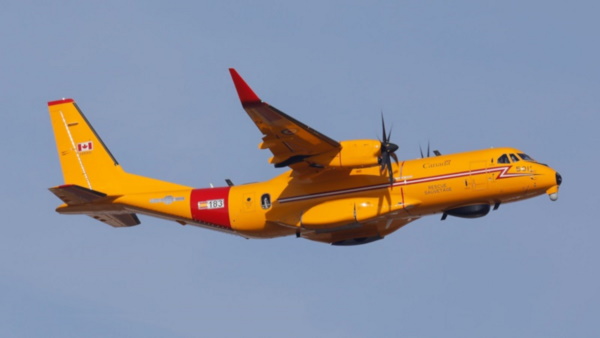
* In the late 1960s, the Spanish military was in need of a modern light cargolifter to replace elderly Douglas C-47 and Junkers Ju 52 piston-powered machines. In response, Construcciones Aeronauticas SA (CASA), Spain's principal aircraft manufacturer, conducted design studies for a new cargolifter, which emerged as the "CASA C212 Aviocar", the prototype performing its initial flight on 26 March 1971. Manufacture of the initial production variant, the "C212 Series 100", originally the "C212-5", began in 1972, with initial service deliveries in the spring of 1974.
As introduced, the C212 Series 100 was a tidy, boxy machine with:
The Aviocar had, somewhat unusually for the era, fixed tricycle landing gear, all gear assemblies with single wheels and the main gear fitted on sponsons. Flight surfaces featured pneumatic de-icing boots, while the props and windshield were electrically de-iced.
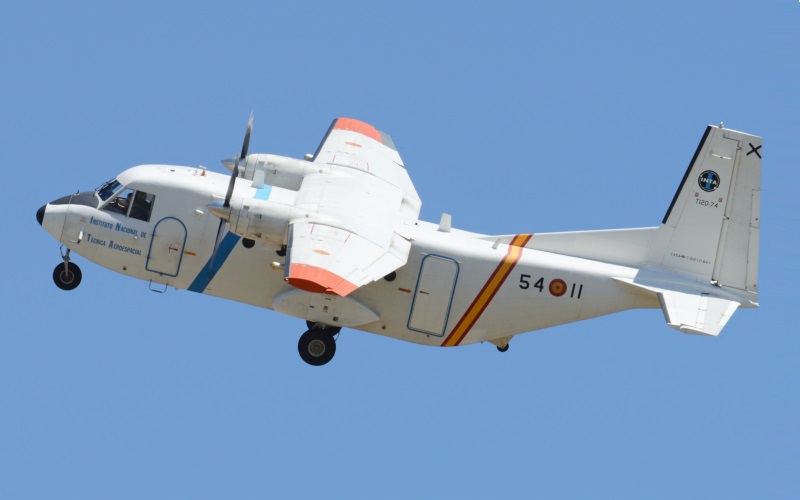
There were two aircrew, with an aircrew door behind the cockpit on the left. There was a passenger door on the rear of the fuselage, also on the left, with emergency exits matching both doors on the right. There was a two-piece tail loading door -- the bottom half hinging down to the ground, with a small wheel on each corner for support, while the top half hinged up to the ceiling of the cargo bay.
In paratroop configuration, the C212 could carry 15 paratroops and a jump instructor, with the tail door used for jumps. Other loads included 12 casualty litters plus up to four medical attendants, or up to 2 tonnes (2.2 tons) of cargo, using a floor roller system for cargo handling and a cargo net for restraint.
A "C212C" civil transport variant was built as well, with seating for 19 passengers in a three-across seating configuration. There was a bulkhead in the rear separating the passenger compartment from the tail doors, with the tail doors permitting access to a baggage compartment. Being unpressurized, the C212 was really only suited to short-haul operations. The C212 Series 100 was also built under license by Industrie Pesawat Terbang Nusantara (IPTN) of Indonesia, now Indonesian Aerospace (IAE).
* A "C212 Series 200" -- originally "C212-10" -- variant was introduced in 1978, featuring the more powerful TPE331-10-501C engine, airframe reinforcements, and higher take-off weights. Some sources claim there was a fuselage stretch as well, but that doesn't appear to have been the case.
The Series 200 was followed in 1984 by the "C212 Series 300", which featured still more powerful TPE331-10R-512C engines; 4-bladed metal Dowty Rotol propellers instead of the 4-bladed Hartzell propellers; winglets; and a stretched nose with a baggage compartment. Paratroop capacity was raised to 24 plus a jumpmaster, while cargo load was increased to 2,700 kilograms (5,950 pounds).
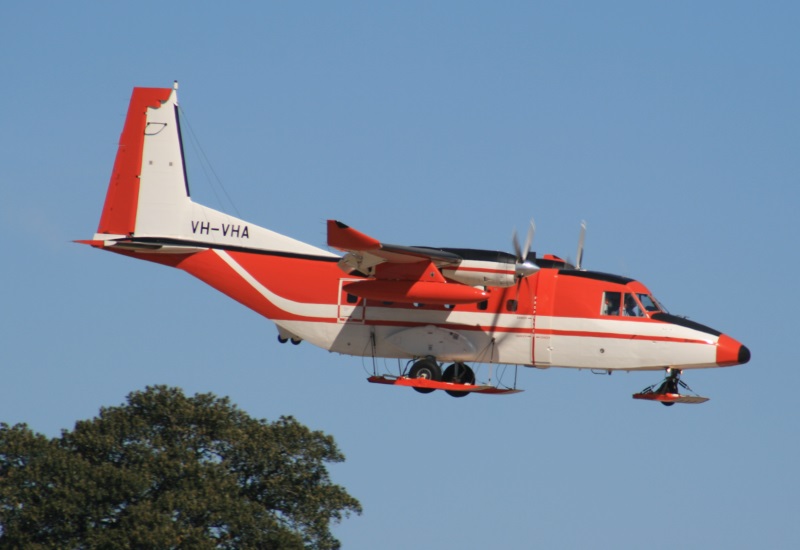
It could also be fitted with a "wet" stores pylon under each wing to carry external stores, generally a fuel tank with a capacity of 500 liters (132 US gallons); it is unclear if the Series 100 or Series 200 could carry external tanks, but it is hard to find imagery of them with such kit. A stores attachment could be fitted on each side of the Series 300's fuselage for carriage of torpedoes, small anti-ship missiles, or gun / rocket pods, but it is also unusual to find images of C212s with the stores racks, and more unusual to find images of them carrying stores. Maximum load on each stores attachment was 250 kilograms (550 pounds).
CASA C212 SERIES 300: _____________________ _________________ _______________________ spec metric english _____________________ _________________ _______________________ wingspan 20.28 meters 66 feet 6 inches wing area 41 sq_meters 441.3 sq_feet length 16.15 meters 53 feet height 6.6 meters 21 feet 8 inches empty weight* 4,400 kilograms 9,700 pounds normal weight 7,700 kilograms 16,975 pounds MTO weight 8,000 kilograms 17,635 pounds cruise speed 355 KPH 220 MPH / 190 KT loaded take-off length 610 meters 2,000 feet loaded landing length 460 meters 1,515 feet service ceiling 7,925 meters 26,000 feet range (max load) 1,435 kilometers 520 MI / 450 NMI range (max fuel)** 2,680 kilometers 1,665 MI / 1,445 NMI _____________________ _________________ _______________________ * Empty weight in equipped freighter configuration.
An airliner variant of the Series 300 was offered with a rear fairing instead of a tail ramp, increasing passenger seating to 21 seats, if a toilet was included, or 23 seats if not. Semi-custom VIP transport configurations were also available.
A "Series 400" was introduced in 1997. It looked externally much like the Series 300, but it was powered by Honeywell TPE-331-12JR engines with a take-off power of 690 kW (925 SHP). Avionics were heavily revised, being relocated generally to the nose and the aircrew given a "glass cockpit" with four displays. The passenger windows went to a square configuration instead of a round configuration, providing a distinctive recognition feature. Incidentally, it seems the name "Aviocar" was eventually downplayed.
* In 2000, CASA became part of the European Aerospace & Defense System (EADS), to become known as EADS-CASA. In 2009, EADS-CASA became a primary component of the new Airbus Military organization, which in late 2013 became a component of Airbus Defense & Space, one of the three parts of the Airbus Group. It is simplest just to call the post-2009 organization "Airbus", and not worry about the convoluted details.
The very last C212 to be produced by Airbus was rolled out in early 2013, but IAE continues to sell an updated "NC212" variant, introduced in 2012. This series features updated avionics, and also commercial passenger seating increased from 25 to 28. The Philippines Air Force has obtained a number of NC212s in military utility configuration. How much longer IAE will continue to build the NC212 is hard to say, but it is a very useful and cost-effective aircraft, which means it's likely to be in service for a long time more.
IAE is developing an "N-219" 19-seat twin-turboprop short-haul airliner, targeted at Indonesian domestic operators. It has a clear resemblance to the C212, but IAE says it is a "clean sheet" design, and distinctly differs from the C212 in features such as a large double loading door on the left rear side of the fuselage. The program has suffered delays, but a prototype finally took to the air on 16 August 2017, with certification following in late 2020.
BACK_TO_TOP* Thanks to its utility, serviceability, and in particular its low cost, the C212 was obtained by dozens of civil operators, plus a similarly long list of government / military users. Government / military operators include:
Brazil signed a contract for obtaining up to 50 C212-400 machines to replace EMBRAER Bandeirante transports in 2006, but the deal was canceled, the Brazilians deciding to update the Bandeirantes instead. However, at least one C212 has been flown in Brazil, it appears by a civil operator, for geophysical survey, this machine featuring a truly bizarre array of antennas and a cable loop strung from nose to wingtips to rear fuselage. The handful of C212s obtained by the USA were for the US Air Force Special Operations Command (AFSOC), with these aircraft designated "C-41A".
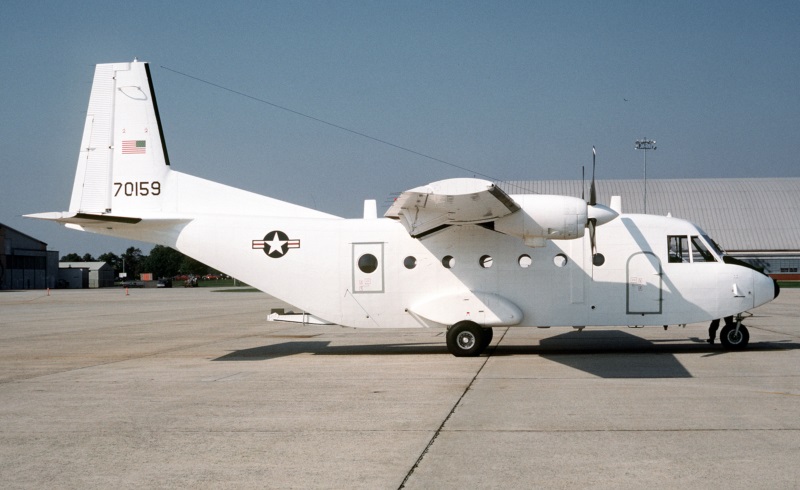
The Spanish Air Force (Ejercito del Aire / EdA) was the biggest single user of the Series 100, obtaining 79 machines, most of the "C212A" basic utility transport variant, known as "T.12B" in EdA service, but including small numbers of other subvariants:
* The C212 being effectively a "flying truck" that can be fitted out with a range of gear, it was adapted to a wide range of special roles, some of which -- like geophysical or photo survey -- were mentioned above. Along with Spain, Portugal and the UAE obtained C212s for EW training.

The C212 proved a useful machine for ocean patrol. Mexico, Portugal, Sweden, Spain, the Sudan, Uruguay (from Portugal), Venezuela, and Vietnam obtained C212 maritime patrol machines, the name "Patrullero" being associated with the role. The Mexican Navy Patrulleros were based on the Series 200 and featured Raytheon Seavue radar, the Airbus "Fully Integrated Tactical System (FITS)", a forward-looking infrared imager (FLIR) turret, and bubble side windows for visual observation.
Other possible kit for patrol C212s included an "electronic surveillance measures (ESM)" system to characterize and locate radar and radio emitters; cameras; rescue gear for airdrop to survivors of an accident; a "magnetic anomaly detector (MAD)" system for anti-submarine warfare (ASW); as well as a sonobuoy / flare-marker dispenser, also for ASW.
BACK_TO_TOP* In 1980, what was then CASA joined forces with IPTN to collaborate under the "Airtech" banner on an improved follow-on to the C212. CASA was the first to fly a prototype of the "CN235", as it was designated, with initial flight on 11 November 1983. IPTN followed, with initial prototype flight on 30 December. Initial production deliveries were in late 1986.
The CN235 -- known as the "CN235M" in strictly military configuration -- is a tidy aircraft with a classic cargolifter configuration, built mostly of aircraft aluminum, with some composite assemblies. The two manufacturers each build different subsets of the airframe, shipping their assemblies to each other for final assembly. The CN235 featured:
The CN235 was pressurized and climate-conditioned. Flight controls were manual, except for hydraulic flap actuation. The flight surfaces featured leading-edge pneumatic de-icing boots, while the props, engine inlets, windscreens, and flight data sensors were electrically de-iced.

Initial engine fit for the initial 30 "Series 10" machines was the General Electric (GE) CT7-7A turboprop, with 1,305 kW (1,750 SHP) take-off power. The engines featured a fire-extinguishing system. After production of 15 Series 10 machines each by CASA and IPTN, in 1988 CN235 production was updated to the CT7-9C engine, with the same power rating but technical improvements, in the "Series 100" -- known as "Series 110" in Indonesian production. The Series 100/110 also featured new composite engine nacelles.
AIRTECH CN235: _____________________ _________________ _______________________ spec metric english _____________________ _________________ _______________________ wingspan 25.8 meters 84 feet 8 inches wing area 59 sq_meters 634.8 sq_feet length 21.4 meters 70 feet 1 inch height 8.18 meters 26 feet 10 inches empty weight 8,800 kilograms 19,400 pounds MTO weight 16,500 kilograms 36,375 pounds cruise speed 460 KPH 285 MPH / 250 KT loaded take-off length 755 meters 2,475 feet loaded landing length 600 meters 1,970 feet service ceiling 8,110 meters 36,600 feet range (max load) 1,500 kilometers 930 MI / 810 NMI range (max fuel) 5,000 kilometers 3,100 MI / 2,700 NMI _____________________ _________________ _______________________
Typical aircrew for a CN235 in civil configuration was pilot, copilot, and a flight attendant, with toilet, galley, and overhead luggage bins standard. Conventional civil aircraft avionics -- radios and navaids -- are fitted, as well as Collins WXR-300 weather radar. There were two doors on each side of the fuselage, one forward and aft:
There was a two-piece tail door that operated much like the door on the CASA 212 -- though it didn't have the distinctive pair of wheels fitted to the tail doors of the C212. In pure airliner configuration, the CN235 could haul 44 to 48 passengers in a four-across arrangement. Airliners had a pressure bulkhead in the rear, but retained the tail doors, which was used for access to a baggage bin.
A "quick-change / combi" variant, the "CN235QC", was developed, capable of hauling four LD3 containers, or 18 passengers and two LD3 containers. In cargolifter configuration, a floor roller system eases handling of cargo. Semi-custom VIP configurations have also been sold.

In CN235M military configuration, the crew typically consisted of pilot, copilot, and loadmaster; photos suggest that the two doors in the rear opened inward for paratroop dropping. The CN235 could carry 48 troops or 46 paratroops, or 24 litters and four attendants for the medevac mission; it could also be fitted with a floor roller system for handling cargo, the maximum cargo load being 5,000 kilograms (11,000 pounds).
The early CN235 Series 100 was replaced in production in 1992 by the "Series 200", with a number of minor tweaks and an increase in operating weights. IPTN came up with a comparable "Series 220" in 1996, but the design tweaks were made generally independently of CASA. CASA went on from the Series 200 to the "Series 300", with:
IPTN/IAE also developed a "Series 330" variant for an Australian requirement -- but didn't win the award, and it didn't happen.
BACK_TO_TOP* As with the C212, the CN235 was acquired by dozens of operators. Government / military operators included:
At least 42 CN235s were obtained by Indonesia; Turkey obtained at least 61, most assembled locally by Turkish Aerospace Industries; Spain acquired 20; South Korea 20; France 19; the USA 14; and Thailand 10. These quantities included special-mission platforms, as discussed below.
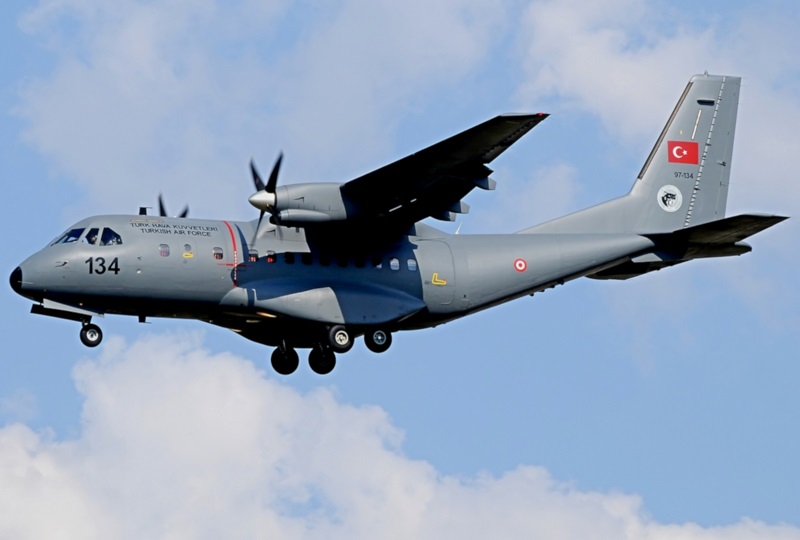
* The CN235 could be configured for special missions such as EW or maritime patrol, and in fact it proved to be a very popular maritime patrol platform. CASA and IPTN went different ways on the concept, however, with CASA offering the "CN235MP Persuader" and IPTN offering the "CN235MPA":
Six underwing stores pylons could be fitted for torpedoes, depth charges, anti-ship missiles, air-to-surface missiles, countermeasures pods, surveillance pods, or searchlights, with pylons rated for carriage of 800, 500, and 300 kilograms (1,760, 1,100, and 660 pounds) from inboard to outboard. It's hard to find any images of a CN235 with more than two pylons. Aircraft systems were coordinated with FITS.

Colombia, Ireland, Mexico, Spain, Turkey, and the USA obtained the CN235MP Persuader; some were upgrades of CN235 airliners, others were new-build. The American variant was obtained by the US Coast Guard (USCG), as the "HC-144A Ocean Sentry", or formally the "Medium Range Surveillance Aircraft". It was based on the CN235-300 variant, featuring a 360-degree search radar in a belly fairing and an undernose camera turret with a forward-looking infrared (FLIR) imager. Mission systems were integrated in a modular pallet that can be easily removed and then re-installed, allowing the aircraft to be used in the cargolift role when necessary. The avionics kit had a high degree of compatibility with the USCG HC-130J Hercules long-range rescue aircraft.

Initial delivery of the Ocean Sentry was in 2007, with an initial batch of 12 machines obtained, replacing the older USCG Dassault Falcon-based HU-25A patrol aircraft. The HC-144 was slower than the HU-25A, but has greater patrol endurance, of up to 11 hours, and greater payload capacity. The rear cargo ramp of the CN235 was retained, allowing it to drop large life rafts or other gear for rescue operations.
The USCG planned to acquire 36 HC-144 machines in all but ran into a budget crunch, with only 18 acquired, the last in 2018. They are being updated to "HC-144B" configuration, featuring an new "Communications, Navigation, Surveillance / Air Traffic Management (CNS/ATM)" avionics system, the updates being completed in 2022. Incidentally, the US Air Force SOCOM operates at least two transport CN235s for special operations; it appears these are hand-me-down machines, though it's not clear who the original operator was.
The CN235MPA was obtained or is being obtained by Brunei, Indonesia, South Korea, and the United Arab Emirates. While Airtech has promoted EW and surveillance / photo-survey variants of the CN235, it is unclear if anyone has obtained such special-purpose machines.
However, in 2011 Jordan signed a contract with ATK to convert two of the country's existing CN235 transports into gunships. The gunships feature an M230 30-millimeter chain gun firing out the left side of the aircraft, plus a stub wing above each main landing gear fairing for external stores. External stores include Hellfire laser-guided missiles or 70-millimeter laser-guided rocket pods, with carriage capacity of up to eight stores. The gunships are fitted with a surveillance / targeting suite, including an imager turret with a laser target designator, as well as a fire-control system for the weaponry. The aircraft were redelivered in 2013.
Other customers have expressed interest in use of the CN235 as a gunship. Other special-mission variants of the CN235 have been considered, including an "airborne early warning (AEW)" system with a Swedish Ericsson Erieye active phased array radar. Nothing came of this concept, and it doesn't seem anyone has acquired EW variants of the CN235, either.
BACK_TO_TOP* In the mid-1990s, what was then EADS-CASA began work on a "stretched" derivative of the CN235, which emerged as the "C295". Initial flight of the prototype, a converted CN235, was on 28 November 1997, with initial flight of the first production C295 on 22 December 1998 and certification following in 1999.
The C295, as it was introduced, is almost identical to the CN235 except for a fuselage extended by 3.1 meters (10 feet), with 50% more payload capacity, larger wing tanks, and more powerful PWC PW127G engines, providing 1,972 kW (2,645 SHP) each, driving six-bladed Hamilton-Standard props. Incidentally, IPTN planned their own stretched machine, the "CN-245", but it didn't happen.
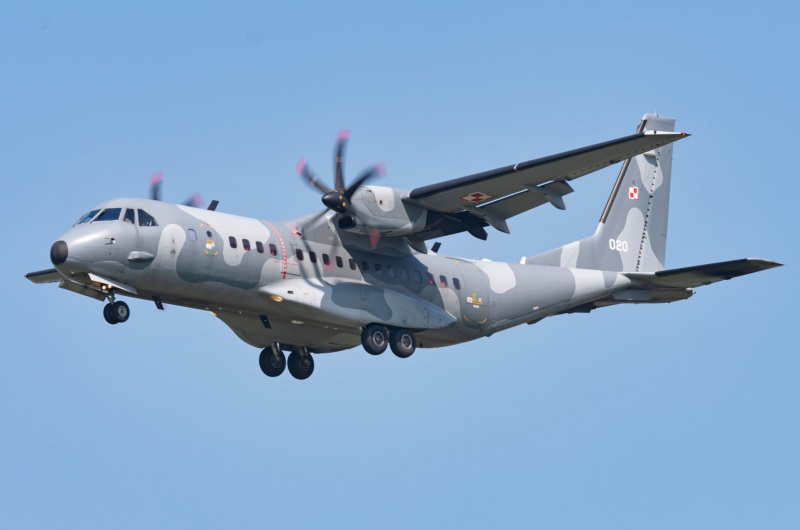
The C295 -- or "C295M" in its military form -- featured a glass cockpit, designed by Thales, compatible with night vision devices (NVD), with optional HUDs. Honeywell RDR-1400C color weather radar was standard. The aircraft could be optionally fitted with a fixed inflight refueling probe. Two crew were normal, with dual controls and a lavatory standard kit. The C295 could haul:
The cargo bay had a volume of 57 cubic meters (2,010 cubic feet); cargo loads included up to five standard pallets, or three light utility vehicles, with a maximum cargo weight of 9,250 kilograms (20,390 pounds).
AIRBUS C295: _____________________ _________________ _______________________ spec metric english _____________________ _________________ _______________________ wingspan 25.8 meters 84 feet 8 inches wing area 59 sq_meters 634.8 sq_feet length 24.5 meters 80 feet 3 inches height 8.6 meters 28 feet 3 inches empty weight 11,000 kilograms 24,250 pounds MTO weight 23,200 kilograms 51,150 pounds cruise speed 480 KPH 300 MPH / 260 KT loaded take-off length 670 meters 2,200 feet loaded landing length 320 meters 1,050 feet service ceiling 9,145 meters 30,000 feet range (max load) 1,455 kilometers 905 MI / 785 NMI range (max fuel) 4,500 kilometers 2,795 MI / 2,430 NMI _____________________ _________________ _______________________
Countries that obtained the C295 or have it on order include Algeria, Angola, Brazil, Chile, Colombia, the Czech Republic, Ecuador, Egypt, Finland, Ghana, India, Indonesia, Jordan, Kazakhstan, Mali, Mexico, Oman, Portugal, Saudi Arabia, Spain, and Uzbekistan; C295s in Spanish service are designated "T.21". Venezuela tried to buy them as well, but the US, at odds with the hostile regime of the late Venezuela strongman Hugo Chavez, managed to block the sale. Winglets have been introduced to improve fuel economy, as well as increase lift capacity by up to 800 kilograms (1,800 pounds), with the first "C295W" delivered to Mexico in 2015.
In 2019, Airbus introduced a further enhanced version of the C295, with the "New C295" featuring:
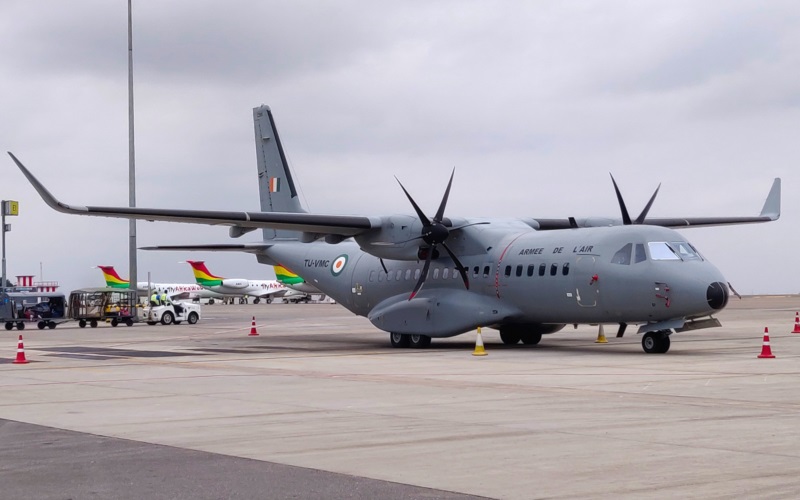
Along with straight transport configurations, special-mission configurations were also offered for the C295:
A number of these special-mission configurations have been sold:
The Finns converted one of their C295s into an airborne surveillance platform, details of which are unclear. Three C295s in military colors were quietly flown to the USA in late 2020, it seems being delivered to L3Harris for conversion into some special-mission platforms, presumably for SOCOM.
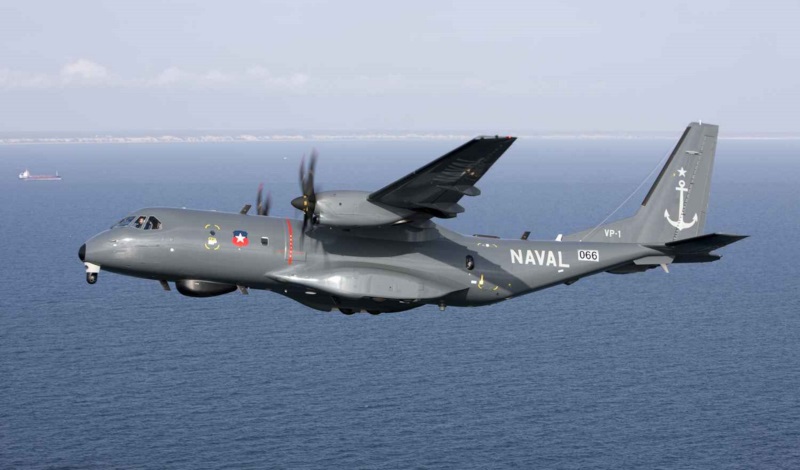
Other new configurations have been considered, or are in the works:
Other improvements in development include improved engines, head-up displays, and an inert gas generation system to reduce fire hazard in the fuel system.
BACK_TO_TOP* I got to talking to a Spanish correspondent about the C212, and commented that it seemed along the lines of Soviet design philosophy: make it cheap, make it simple, make it rugged, make it easy to maintain. The reply was that at the time, the Spanish military was dependent on minimally-trained conscripts, and so simplicity was an important factor in equipment procurement.
Trying to track down specifics on the CASA transports ended up being something of an exercise in frustration, there being no great number of detailed sources on the types, with the highly variable operational configurations of these aircraft complicating matters. I was, however, happy to get a shot of a C212 of my own down at Denver International Airport; maybe I'll get photos of an HC-144 at an airshow one of these days.

* Sources include:
I referenced all the JANE'S ALL THE WORLD'S AIRCRAFT I could find, and also found quite a few bits and pieces on the internet. Hopefully I'll be able to track down more information for later releases.
* Illustration credits:
* Revision history:
v1.0.0 / 01 apr 11 /
v1.1.0 / 01 may 11 / Follow-up cleanup release.
v1.2.0 / 01 apr 13 / C295 AEW, Oman obtains C295MPA.
C295 winglets & Marte missile.
v1.3.0 / 01 mar 15 / General cleanup, Airbus name changes.
v1.3.1 / 01 feb 17 / Winglet C295 to Mexico.
v1.3.2 / 01 jan 19 / Review, update, & polish.
v1.3.3 / 01 feb 21 / Review, update, & polish.
v1.4.0 / 01 nov 21 / Review, update, & polish.
BACK_TO_TOP
